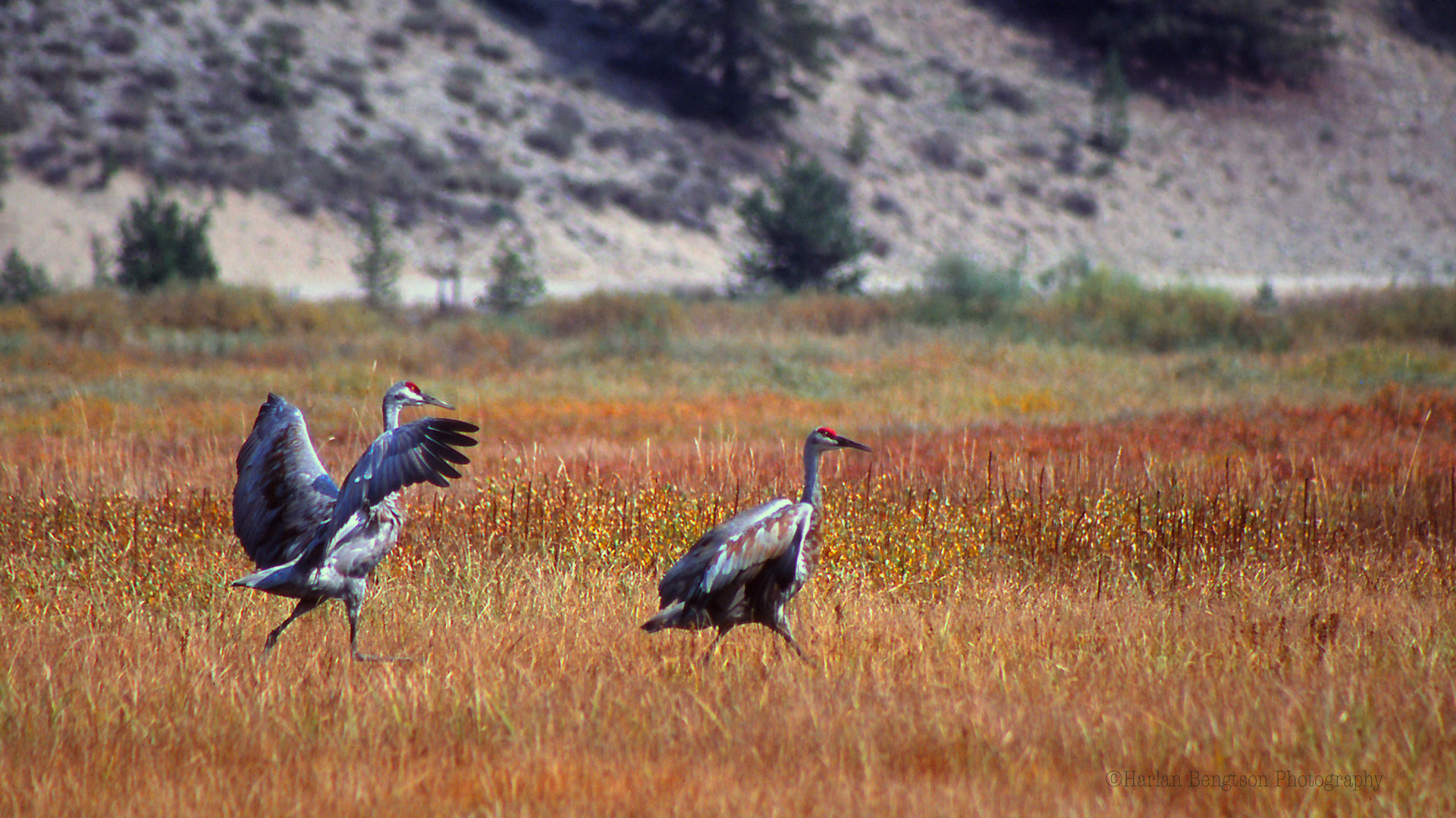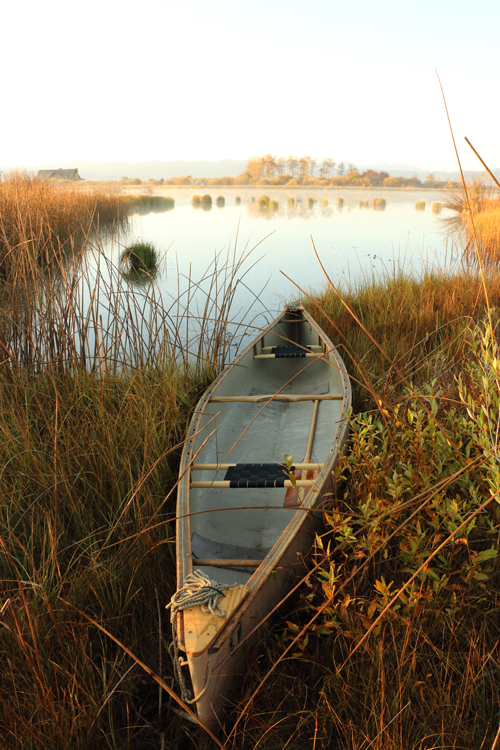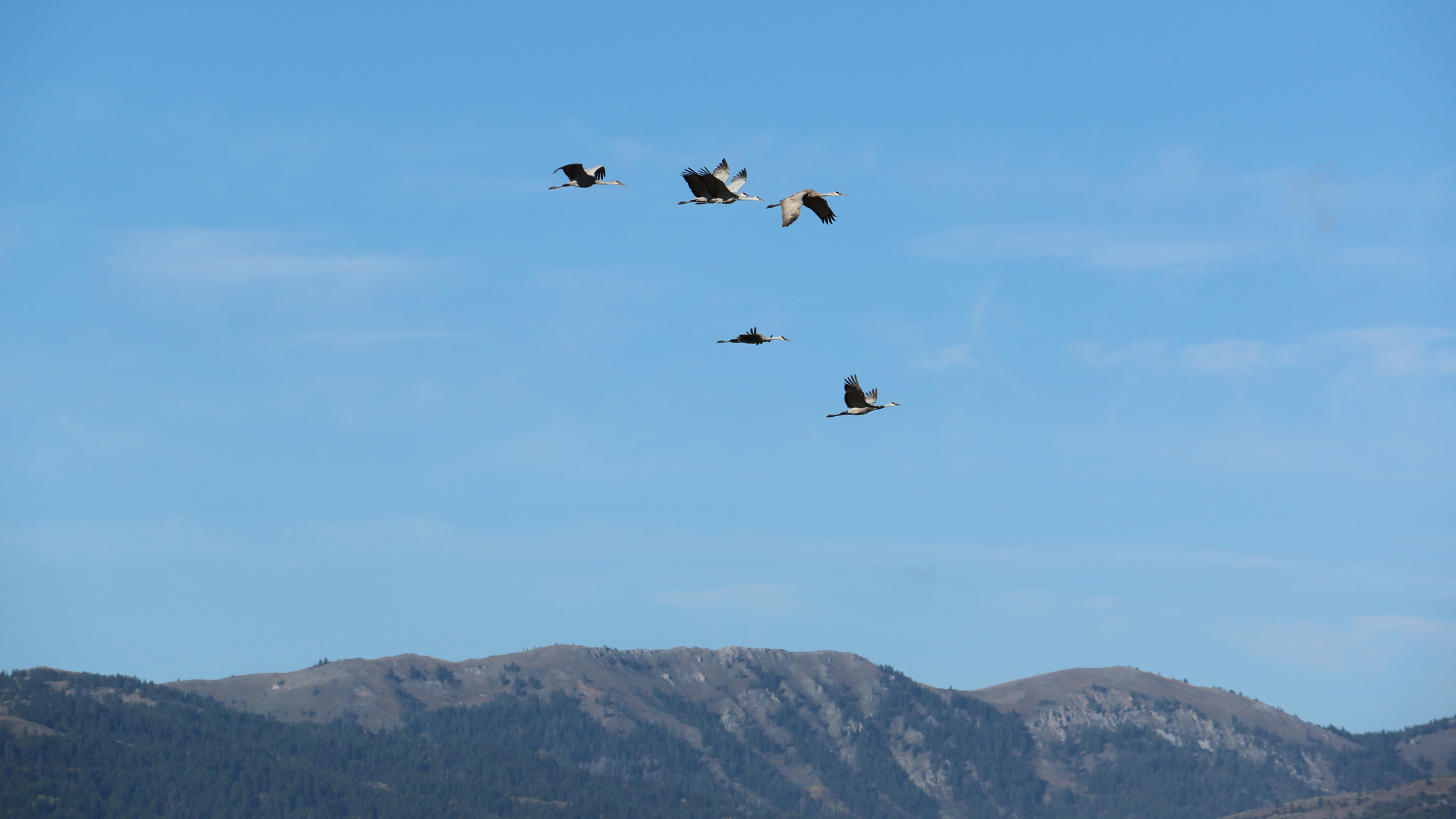Having my camera on the water in the dark makes me nervous, but I trust the man with the paddle. It’s Rob Cavallaro, an Idaho Department of Fish and Game wildlife biologist. He’s canoeing me and my camera to a blind in the middle of a marsh in Teton Valley, Idaho. We have to arrive sightless and soundless before the sun comes up for a decent shot at seeing cranes.
“It is no accident that they’re here,” Cavallaro says. “They’re here for a very specific alignment of resources.”
Cranes congregate in areas offering large wetlands for roosting that are right next to grain fields for foraging. I’m hiding where the two land types meet and my lens is poking out of the blind. I’m picking up sound, but there’s still not enough light for me to record a decent image. I hear calls coming from every direction. The cranes are moving from their bed to their breakfast.
The sun finally rises over the towering Teton Mountain Range in the east and soft, autumn light spills across a valley of tall grass and even taller birds bouncing around with long-legged grace.
“You’ll look out into a field and wonder what you’re looking at,” says Joselin Matkins, Teton Regional Land Trust (TRLT) executive director. “It looks like a small cow, but you get your eyes accustomed to it and these giant birds are out there. It’s just like nothing else.”
The giant birds are greater sandhill cranes. Hundreds of them. The lean, gray animal lives up to 50 years, weighs 14 pounds and has a six-foot wingspan. Cranes are in the valley to feast before their migration to Mexico. They’re also here to mate and they announce their lifelong commitment with grand flare.
“You’ll see a lot of dancing, preening and a lot of unison calling,” Cavallaro says. “Part of the display is sometimes before or after dancing, they’ll pick up sod or grass and throw it up in the air and that just makes the dance a little more dramatic.”

One of the best places to see this spectacle in Idaho is the Conservancy’s Flat Ranch Preserve, located west of West Yellowstone (and north of the Teton Valley). Cranes can easily be spotted dancing and rearing young from the visitor center – where a spotting scope allows close-up views without disturbing the birds.
While cranes are not especially difficult to find in eastern Idaho, cranes have fallen on hard times. The dramatic show started declining at the turn of this century. In the 1990s, 5,000 greater sandhill cranes stopped in Teton Valley in the fall. Now that number is down to 1,500.

While overhunting initially impacted crane numbers, habitat loss remains the fundamental threat. The most common wetland loss happens in low-lying areas like the Teton Valley, where the birds prep for migration. Idaho has lost 56 percent of its original wetlands, a trend mirrored across the country.
Cavallaro and Matkins are part of the decade-long recovery effort to keep cranes on the landscape. They work with farmers by harvesting certain grain fields early to lure cranes in while keeping them out of other grain fields that are just about ready to be cut.
The Idaho Department of Fish and Game works with TRLT to develop food plots in protected areas – largely conservation easement properties. Instead of harvesting the protected areas, the grain is mowed and left for forage.
Some grain fields are also purchased at market value by TRLT; that grain is also mowed.
It’s a delicate balancing act between ranch and resource and it’s working. Crane numbers are increasing and the highly visible, and audible, flock of feathers is creating conservation awareness in the valley.
“People really care about cranes and what they’re doing. That makes them a perfect species to be an emblem for conservation,” Cavallaro says. “When you’re involved in conservation, it’s very important to have a species that will engage people and sandhill cranes really do that.”

Many birders associate cranes with the huge migrations from Canada to the Gulf, including the famous staging along the Platte River in Nebraska. These are lesser sandhill cranes: they’re smaller and travel farther than the greaters staging in Idaho. They’re also more numerous: there are 500,000 lessers compared to only 20,000 greaters.
But cranes have become an emblematic bird of the Greater Yellowstone region, including the Teton Valley. And if you protect habitat for the crane, you protect habitat for a host of other wildlife.
“By working with partners who can protect habitat for cranes, we’re also protecting habitat for moose, fish, waterfowl,” Cavallero continues. “They’re a species of greatest conservation need and there’s been concern about their numbers, but perhaps their greatest importance is their ability to be a catalyst for conservation.”



Wonderful story; So great to know that incredibly important work is being done and that people beaware of it…. It seems all we hear these days are ‘Doom + Gloom’ reports of yet another species and its ecosystem are floundering or lost, altogether. Keep up the great work, creating hope for the future of our precious creatures and their homes !!!!!
A similar program is hugely successful in Eastern Washington state where a major flyway sees Sandhills migrate from Alaska to Butte County, CA every spring and return in the fall. Under the leadership of Randy Hill, a USF&W biologist, land was leased from farmers who grow grain crops, harvest at a profit, but do not till the remaining stalks. Although Randy has moved on, his work continues to produce results. The little town of Othello, WA hosts a Sandhill Crane Festival every spring. See: http://www.othellosandhillcranefestival.org. Birders come not only from all over the west, but from around the world to see cranes, owls, curlews and other birds and take tours of the extensive farmland surrounding Othello. The Festival includes children’s activities, art, book signings, workshops, and guest speakers.
we need to be part of the process of conserving and protecting our ecosystem and animal/fowl species.
I wonder if all the pesticides that the farmers use on the grains that you are proposing they leave behind would actually do more harm than good to the wildlife.
I’m a birder. I also am for the wildlife and I want to see the habitat protected. Humans may need land, etc but so does wildlife. We need to protect our wildlife!
The Cranes in Idaho don’t migrate south to Mexico, but rather to the Bosque del Apache National Wildlife Refuge in South Central New Mexico, where they winter.
My one question is: don’t all cranes eat small animals, reptiles, & insects? As far as I know, they’re not interested in grains, so why would farmers care? They ought to be thrilled that these birds consume enemies of their crops!!
I wonder if I can answer your question. While eating breakfast in a Driggs, Idaho coffee shop one morning in September I overheard a group of farmers quietly bantering about the large feet of the cranes – that a few sets of the wide crane feet walking over their grain fields was negligible, but hundreds or even thousands of these feet foraging about cause damage by breaking down the stalks before harvest. I found the subject of the conversation both humorous and of interest in the relationship between the farmer and the crane on a “grass roots” (no pun intended) local level.
In the Bible we read that farmers were instructed to leave some grain in the field for the poor. May they do so now for wildlife.
The cranes are in western Colorado every year. Their calls can almost drowned out your thoughts…..I love it.